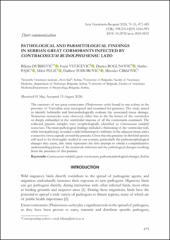| dc.contributor.author | Đurđević, Biljana | |
| dc.contributor.author | Vučićević, Ivana | |
| dc.contributor.author | Bogunović, Danica | |
| dc.contributor.author | Pajić, Marko | |
| dc.contributor.author | Pelić, Miloš | |
| dc.contributor.author | Todorović, Dalibor | |
| dc.contributor.author | Ćirković, Miroslav | |
| dc.date.accessioned | 2024-09-25T09:59:58Z | |
| dc.date.available | 2024-09-25T09:59:58Z | |
| dc.date.issued | 2024 | |
| dc.identifier.issn | 0567-8315 | |
| dc.identifier.uri | https://repo.niv.ns.ac.rs/xmlui/handle/123456789/868 | |
| dc.description.abstract | The carcasses of ten great cormorants (Phalacrocorax carbo) found in one colony in the province of vojvodina were necropsied and examined for parasites. The study aimed to identify helminths and histopathologically evaluate the associated tissue damage. numerous nematodes were observed, either free in the the lumen of the ventriculus or deeply embedded in the ventricular mucosa of all the cormorants examined. The collected parasite samples were morphologically identified as Contracaecum rudolphii sensu lato. The main pathological findings included a thickening of the ventricular wall, while histopathology revealed a mild inflammatory infiltrate in the adjacent tissue and a connective tissue capsule around the parasite. Given that the parasites in this bird species still need to be thoroughly studied in our country, particularly the pathomorphological changes they cause, this study represents the first attempt to obtain a comprehensive understanding picture of the nematode infection and the pathological changes resulting from the presence of this parasite. | en_US |
| dc.description.sponsorship | The study was supported by the Ministry of Science, Technological development and innovation of the republic of Serbia (Contract number 451-03-66/2024-03/200143 and 451-03-66/2024-03/200031). | en_US |
| dc.language.iso | en | en_US |
| dc.source | Acta veterinaria - Beograd | en_US |
| dc.subject | Contracaecum rudolphii | en_US |
| dc.subject | great cormorant | en_US |
| dc.subject | pathomorphological changes | en_US |
| dc.subject | Serbia | en_US |
| dc.title | Pathological and parasitological findings in Serbian great cormorants infected by Contracoecum rudolphii sensu lato | en_US |
| dc.title.alternative | Infekcija velikih kormorana u Srbiji parazitom Contracoecum rudolphii sensu lato – parazitološki i patološki nalaz | en_US |
| dc.type | Article | en_US |
| dc.identifier.doi | 10.2478/acve-2024-0032 | |
| dc.citation.volume | 74 | en_US |
| dc.citation.issue | 3 | en_US |
| dc.citation.spage | 472 | en_US |
| dc.citation.epage | 483 | en_US |
| dc.citation.rank | M23 | en_US |
| dc.type.version | published | en_US |

